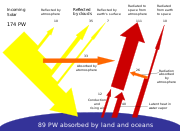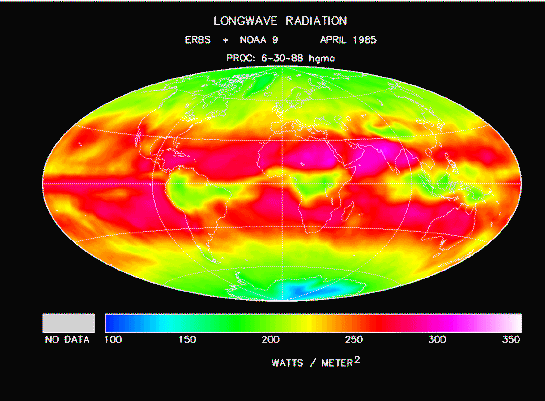
Earth's energy budget
Encyclopedia


Earth
Earth is the third planet from the Sun, and the densest and fifth-largest of the eight planets in the Solar System. It is also the largest of the Solar System's four terrestrial planets...
can be considered as a physical system with an energy budget
Energy budget
An energy budget is a balance sheet of energy income against expenditure. It is studied in the field of Energetics which deals with the study of energy transfer and transformation from one form to another. Calorie is the basic unit of measurement...
that includes all gains of incoming energy and all losses of outgoing energy. The planet is approximately in equilibrium, so the sum of the gains is approximately equal to the sum of the losses.
Note on accompanying images: These graphics depict only net energy transfer. There is no attempt to depict the role of greenhouse gas
Greenhouse gas
A greenhouse gas is a gas in an atmosphere that absorbs and emits radiation within the thermal infrared range. This process is the fundamental cause of the greenhouse effect. The primary greenhouse gases in the Earth's atmosphere are water vapor, carbon dioxide, methane, nitrous oxide, and ozone...
es and the exchange that occurs between the Earth's surface and the atmosphere or any other exchanges.
Incoming energy
The total solar flux of energy entering the Earth's atmosphere is estimated at 174 petaPeta (prefix)
Peta- is a prefix in the metric system denoting 1015 or . For example:1 petametre = 1015 metres1 petasecond = 1015 seconds...
watt
Watt
The watt is a derived unit of power in the International System of Units , named after the Scottish engineer James Watt . The unit, defined as one joule per second, measures the rate of energy conversion.-Definition:...
s. This flux consists of:
- solar radiation (99.97%, or nearly 173 petawatts; or about 340 W m−2)
- This is equal to the product of the solar constantSolar constantThe solar constant, a measure of flux density, is the amount of incoming solar electromagnetic radiation per unit area that would be incident on a plane perpendicular to the rays, at a distance of one astronomical unit...
, about 1,366 watts per square metre, and the area of the Earth's disc as seen from the Sun, about 1.28 × 1014 square metres, averaged over the Earth's surface, which is four times larger. The solar flux averaged over just the sunlit half of the Earth's surface is about 680 W m−2 - This is the incident energy. The energy actually absorbed by the earth is lower by a factor of the co-albedo; this is discussed in the next section.
- Note that the solar constant varies (by approximately 0.1% over a solar cycle); and is not known absolutely to within better than about one watt per square metre. Hence geothermal, tidal, and waste heat contributions are less uncertain than solar power.
- This is equal to the product of the solar constant
- geothermal energy (0.025%; or about 44 to 47 terawatts; or about 0.08 W m−2)
- This is produced by stored heat and heat produced by radioactive decay leaking out of the Earth's interior.
- tidal energyTideTides are the rise and fall of sea levels caused by the combined effects of the gravitational forces exerted by the moon and the sun and the rotation of the Earth....
(0.002%, or about 3 terawatts; or about 0.0059 W m−2)- This is produced by the interaction of the Earth's mass with the gravitational fields of other bodies such as the Moon and Sun.
- waste heatWaste heatWaste heat sometimes called Secondary heat or Low-grade heat refers to heat produced by machines, electrical equipment and industrial processes for which no useful application is found. Energy is often produced by a heat engine, running on a source of high-temperature heat...
from fossil fuelFossil fuelFossil fuels are fuels formed by natural processes such as anaerobic decomposition of buried dead organisms. The age of the organisms and their resulting fossil fuels is typically millions of years, and sometimes exceeds 650 million years...
consumption (about 0.007%, or about 13 terawatts; or about 0.025 W m−2) The total energy used by commercial energy sources from 1880 to 2000 (including fossil fuels and nuclear) is calculated to be 17.3x1021Joules.
There are other minor sources' of energy that are usually ignored in these calculations: accretion of interplanetary dust and solar wind, light from distant stars, the thermal radiation of space. Although these are now known to be negligibly small, this was not always obvious: Joseph Fourier
Joseph Fourier
Jean Baptiste Joseph Fourier was a French mathematician and physicist best known for initiating the investigation of Fourier series and their applications to problems of heat transfer and vibrations. The Fourier transform and Fourier's Law are also named in his honour...
initially thought radiation from deep space was significant when he discussed the Earth's energy budget in a paper often cited as the first on the greenhouse effect.
Outgoing energy
The average albedoAlbedo
Albedo , or reflection coefficient, is the diffuse reflectivity or reflecting power of a surface. It is defined as the ratio of reflected radiation from the surface to incident radiation upon it...
(reflectivity) of the Earth is about 0.3, which means that 30% of the incident solar energy is reflected into space, while 70% is absorbed by the Earth and reradiated as infrared
Infrared
Infrared light is electromagnetic radiation with a wavelength longer than that of visible light, measured from the nominal edge of visible red light at 0.74 micrometres , and extending conventionally to 300 µm...
. The planet's albedo varies from month to month and place to place, but 0.3 is the average figure. The contributions from geothermal and tidal power sources are so small that they are omitted from the following calculations.
30% of the incident energy is reflected, consisting of:
- 6% reflected from the atmosphereEarth's atmosphereThe atmosphere of Earth is a layer of gases surrounding the planet Earth that is retained by Earth's gravity. The atmosphere protects life on Earth by absorbing ultraviolet solar radiation, warming the surface through heat retention , and reducing temperature extremes between day and night...
- 20% reflected from cloudCloudA cloud is a visible mass of liquid droplets or frozen crystals made of water and/or various chemicals suspended in the atmosphere above the surface of a planetary body. They are also known as aerosols. Clouds in Earth's atmosphere are studied in the cloud physics branch of meteorology...
s - 4% reflected from the ground (including land, water and ice)

- 51% is absorbed by land and water, and then emerges in the following ways:
- 23% is transferred back into the atmosphere as latent heatLatent heatLatent heat is the heat released or absorbed by a chemical substance or a thermodynamic system during a process that occurs without a change in temperature. A typical example is a change of state of matter, meaning a phase transition such as the melting of ice or the boiling of water. The term was...
by the evaporationEvaporationEvaporation is a type of vaporization of a liquid that occurs only on the surface of a liquid. The other type of vaporization is boiling, which, instead, occurs on the entire mass of the liquid....
of water, called latent heat flux - 7% is transferred back into the atmosphere by heated rising air, called Sensible heat flux
- 6% is radiated directly into space
- 15% is transferred into the atmosphere by radiation, then reradiated into space
- 23% is transferred back into the atmosphere as latent heat
- 19% is absorbed by the atmosphere and clouds, including:
- 16% reradiated into space
- 3% transferred to clouds, from where it is radiated back into space
When the Earth is at thermal equilibrium, the same 70% that is absorbed is reradiated:
- 64% by the clouds and atmosphere
- 6% by the ground
.
See also
- World energy resources and consumptionWorld energy resources and consumption]World energy consumption in 2010: over 5% growthEnergy markets have combined crisis recovery and strong industry dynamism. Energy consumption in the G20 soared by more than 5% in 2010, after the slight decrease of 2009. This strong increase is the result of two converging trends...
- Orders of magnitude (power)Orders of magnitude (power)This page lists examples of the power in watts produced by various sources of energy. They are grouped by orders of magnitude, and each section covers three orders of magnitude, or a factor of one thousand.-zeptowatt :...
, for comparisons with other quantities of power. - Greenhouse effectGreenhouse effectThe greenhouse effect is a process by which thermal radiation from a planetary surface is absorbed by atmospheric greenhouse gases, and is re-radiated in all directions. Since part of this re-radiation is back towards the surface, energy is transferred to the surface and the lower atmosphere...

